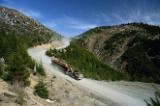 © Pete Saloutos/Panoramic Images (Washington Title Image Large)
© Pete Saloutos/Panoramic Images (Washington Title Image Large)

Threats and Issues
Washingtonians are blessed with a rich natural heritage. Yet we cannot take the continued existence of that heritage for granted. A number of challenging issues remain: population growth and subsequent development, on-going loss of habitat, the increased need for water storage capacity and new sources of energy, altered natural processes (e.g., more frequent and severe wildfires), invasive species, and of course, climate change.
The challenge ahead is to make informed decisions about growth and development and our use of natural resources so that we can sustain an ecologically, economically and socially healthy Washington. A number of threats/issues are discussed below and in greater detail as you drill deeper into this website.
Primary Threats to Conservation in Washington
-
Development Pressures in Washington
Population growth and the accompanying development are major drivers of the threats to Washington's biodiversity. Our population is currently more than 6 million, having doubled in the last 40 years. By the year 2030, Washington is expected to have more than 8 million reisdents.
-
Habitat Loss in Washington
Land conversion resulting in the loss of suitability of habitat is arguably the single most important factor responsible for the long lists of species and ecosystems of concern in Washington. Lands have been, and continue to be, converted for residential, commercial, and agricultural purposes, construction of roads and railroads, and construction of dams and other means of controlling the flow of water.
-
Invasive Species in Washington
Non-native invasive plant and animal species cause significant economic impact to property owners, farmers and ranchers, people involved in aquaculture and fisheries, and others as a result of reduced yields and the cost of control/eradication efforts. There are also tremendous environmental impacts.
-
Water Quality and Supply in Washington
The growth and development of the state of Washington has been accompanied by, and perhaps been dependent upon, controlling the flow of water. Construction of dams, levees and dikes has provided flood control, electricity and water for irrigation. But it has also resulted in significant declines in riparian ecosystems and the species dependent on those systems.
-
Altered Processes in Washington
Natural disturbances, such as fire, flooding, windstorms, and outbreaks of disease, play an important role in the patterns of abundance, distribution, and species composition of ecosystems. Human disruption of natural disturbance processes, such as fires and floods, has had far-reaching impacts on species and ecosystems in Washington.
-
Energy Development in Washington
There has been considerable interest of late in the development of more environmentally-friendly sources of energy, including wind power and bio-fuels. However, as we seek cheaper and cleaner energy sources, care needs to be taken to avoid putting biodiversity at greater risk.
-
Climate Change in Washington
Climate change will likely reshape our ecosystems and alter the mix of species that live within Washington. Rising sea level will impact nearshore habitats (beaches, tidepools, etc.) and estuaries. The food web within Puget Sound, riparian habitats and our forest ecosystems will undergo change.













